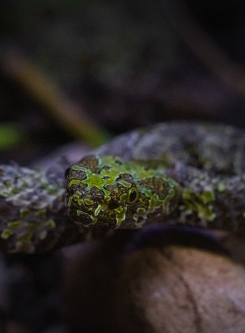
This species has a very small distribution area, no more than 300 km², and it’s estimated that only around 400 specimens remain in the wild, which is why it’s considered endangered.
Unfortunately, the moss viper faces significant threats primarily due to the international pet trade and its use in traditional Chinese medicine. These activities lead to it being sold in markets in cities like Shenzhen, Quanzhou, and Hong Kong.
The moss viper species was discovered in September 1989. Following its discovery, the area it inhabits was declared a national park in 1992. To provide even stronger protection, it was then established as the Mangshan Mountain Nature Reserve in 1994.
In China, capturing these animals is taken so seriously that, since 1990, it has been prohibited and can even lead to the death penalty. This underscores their status as one of the country’s most protected animals, second only to the giant panda.
A species that deserves all our attention, care, and conservation!
| Dimensions | Up to 200 cm |
| Danger Level | lethal |
| Venom Effects | hemotoxic |
| Reproduction | oviparous |
| Diet | carnivore |
| Habitat | subtropical mountainous forests |






































































